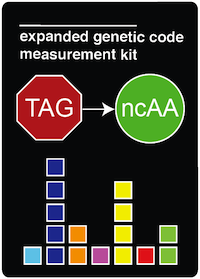Team:Austin Texas
From 2014.igem.org
(Difference between revisions)
| Line 73: | Line 73: | ||
<!-- WIKI CONTENT BEGINS --> | <!-- WIKI CONTENT BEGINS --> | ||
| - | + | {| | |
| + | |- valign="top" | ||
| + | | [[Image:Austin_Texas_Measurement_Kit_Card.png]] | ||
| + | | | ||
| + | <h3>ncAA Kit Project</h3> | ||
| - | + | Noncanonical amino acids (ncAAs) are an exciting new tool in the biological researchers toolbox. Incorporating ncAAs into proteins will allow scientists to create bacteria that can perform novel or new functions. The amberless E. coli used in this kit have had all the amber stop codons in its genome recoded and removed to allow the amber codon to be used for ncAAs. Unfortunately, these noncanonical amino acids are often difficult to incorporate into proteins due to a low fidelity of the synthetase/tRNA pair. Our project aims to create a kit that can measure the fidelity of the synthetase/tRNA pair and incorporation of several different noncanonical amino acids into fluorescent proteins. The kit is a simple two-plasmid system. The first plasmid contains an IPTG-inducible RFP, followed by a linker sequence containing a recoded amber stop codon (where the ncAA will be incorporated) and sfGFP. The other plasmid contains the synthetase/tRNA pair. When the RFP-linker-GFP protein is induced and exposed to the excitation wavelengths for RFP and GFP, the fluorescence of both parts of the fusion protein can be measured and compared. Depending on the relative intensities of the RFP and GFP fluorescent proteins, we can determine how efficient the synthetase/tRNA pairs are at incorporating the ncAA. We plan to equip researchers with a quick and easy “plug and play” system that contains easily interchangeable parts. Researchers will be able to insert any plasmid containing a new synthetase/tRNA pair into our pre-made cells to test the fidelity and incorporation of various ncAAs. | |
| - | + | |- valign="top" | |
| - | + | | | |
| - | + | | <h3>Photocage Project</h3> | |
| - | + | ||
| - | + | ||
| - | ( | + | |
| - | + | ||
| - | + | ||
| - | + | ||
| - | + | ||
| - | + | ||
| - | + | ||
| - | + | ||
| - | + | ||
| - | + | ||
| - | + | ||
| - | <h3>Photocage Project</h3> | + | |
Amino acids not included in the native 20 are commonly known as noncanonical amino acids (ncAAs). These ncAAs have unique chemistry that can provide very useful functionality not normally present in an organism. For our purposes, ncAAs were used to prevent protein functionality until spatially and/or temporally triggered. | Amino acids not included in the native 20 are commonly known as noncanonical amino acids (ncAAs). These ncAAs have unique chemistry that can provide very useful functionality not normally present in an organism. For our purposes, ncAAs were used to prevent protein functionality until spatially and/or temporally triggered. | ||
This summer our team has been working on recreating a lightactivatable T7 RNA Polymerase (RNAP) for a method of noninvasive, spaciotemporal control of protein expression. T7 RNAP was our enzyme of choice for this project due to the presence of a tyrosine residue in the active site of the polymerase. By recoding this tyrosine residue, orthonitrobenzyl tyrosine was incorporated into the active site thus acting as a molecular cage. T7 RNAP is only functional when exposed to a certain wavelength of light that cleaves a molecular cage from the polymerase’s active site. In our experiments, orthonitrobenzyl tyrosine (ONBY) was used as our photocaged ncAA. ONBY was used because once the ONB group is cleaved off, the ncAA functions as a normal tyrosine. This proved to be particularly useful because T7 polymerase has a tyrosine residue in its active site that is necessary for proper function of the protein. Once decaged, the polymerase is free to transcribe sequences that are preceded by a T7 promoter. GFP was used as a reporter to analyze and optimize each construct for spaciotemporal specificity. In addition, GFP was used to examine the effect of a certain noncanonical amino acid on fluorescence when placed in the fluorophore. | This summer our team has been working on recreating a lightactivatable T7 RNA Polymerase (RNAP) for a method of noninvasive, spaciotemporal control of protein expression. T7 RNAP was our enzyme of choice for this project due to the presence of a tyrosine residue in the active site of the polymerase. By recoding this tyrosine residue, orthonitrobenzyl tyrosine was incorporated into the active site thus acting as a molecular cage. T7 RNAP is only functional when exposed to a certain wavelength of light that cleaves a molecular cage from the polymerase’s active site. In our experiments, orthonitrobenzyl tyrosine (ONBY) was used as our photocaged ncAA. ONBY was used because once the ONB group is cleaved off, the ncAA functions as a normal tyrosine. This proved to be particularly useful because T7 polymerase has a tyrosine residue in its active site that is necessary for proper function of the protein. Once decaged, the polymerase is free to transcribe sequences that are preceded by a T7 promoter. GFP was used as a reporter to analyze and optimize each construct for spaciotemporal specificity. In addition, GFP was used to examine the effect of a certain noncanonical amino acid on fluorescence when placed in the fluorophore. | ||
| - | + | |} | |
| - | + | ||
| - | + | ||
| - | + | ||
<!-- WIKI CONTENT ENDS --> | <!-- WIKI CONTENT ENDS --> | ||
Revision as of 03:41, 16 October 2014
| |||||||||||||||||||||||||||
 "
"


